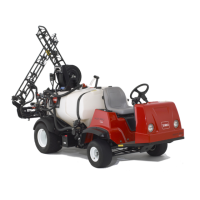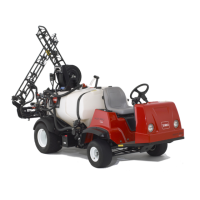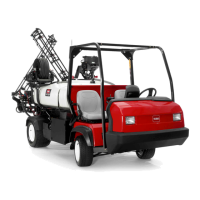38
MAINTENANCE
CLUTCH SYSTEM AND CVT BELT:
1. Proper Operation of Clutch:
A. Idle - 1000 - 1100 RPM Driven Pulley
stationary; Belt not moving.
B. Accelerate - Clutch Drive Clamps Belt and
Driven Pulley Rotates.
2. Critical Factors:
A. Idle RPM 1000 - 1100.
B. Belt Guide - Guide should be a distance
of 1/8" from Driven Pulley edge. (See FIG.
22)
C. Belt Condition - Any Belt that has operated
for 10 minutes is considered a used Belt.
D. Wear marks, cracks in Belt.
E . CVT BELT SHOULD NEVER NEED
ADJUSTING.
3. Trouble Shooting:
A. Idle too high - adjust Engine idle.
B. Belt Guides loose or mislocated - adjust
per FIG. 22.
C. Clutch Components worn - replace com-
ponents as needed.
D. Belt - replace as needed.
DANGER
Rotating Pulleys and Belts can cause
serious injury.
Keep hands, feet, and clothing clear
while engine is running.
Stop engine before attempting any belt
adjustment.
STEERING PUMP BELT TENSION:
The optimal tension for a V-Belt drive is the lowest
tension at which the Belts will not slip under the
highest load condition. Too much tension
shortens Belt and Bearing life.
Check tension and wear of all belts initially after
the first day of operation and every 100 hours
thereafter.
2. TO ADJUST BELT TENSION:
A. Loosen Pump Bracket Screws at Engine
Mounting Plate.
B. Slide Pump Bracket to increase tension
and tighten screw. Tighten screw closest
to engine crankshaft first.
FIG. 23
1. CVT Belt
2. Belt Guide
FIG. 22
1831
1
1832
1
2
3
1. Steering Pump Belt
2. Pump Bracket Screw
3. Engine Mtg Plate
1. Check tension by depressing belt at mid span
of pump and engine shaft pulleys with 5 lbs. of
force. A new belt should deflect .19 - .25 inch. A
used belt should deflect .25 - 31 inch. If deflection
is incorrect, proceed to next step. If deflection is
correct, continue operation.
3. Driven Pulley
2
2
3

